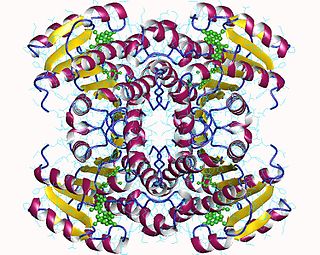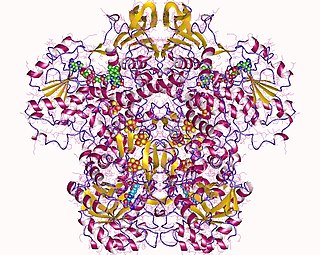
Nicotinamide adenine dinucleotide phosphate, abbreviated NADP+ or, in older notation, TPN (triphosphopyridine nucleotide), is a cofactor used in anabolic reactions, such as the Calvin cycle and lipid and nucleic acid syntheses, which require NADPH as a reducing agent ('hydrogen source'). NADPH is the reduced form of NADP+, the oxidized form. NADP+ is used by all forms of cellular life.

Isocitrate dehydrogenase (IDH) (EC 1.1.1.42) and (EC 1.1.1.41) is an enzyme that catalyzes the oxidative decarboxylation of isocitrate, producing alpha-ketoglutarate (α-ketoglutarate) and CO2. This is a two-step process, which involves oxidation of isocitrate (a secondary alcohol) to oxalosuccinate (a ketone), followed by the decarboxylation of the carboxyl group beta to the ketone, forming alpha-ketoglutarate. In humans, IDH exists in three isoforms: IDH3 catalyzes the third step of the citric acid cycle while converting NAD+ to NADH in the mitochondria. The isoforms IDH1 and IDH2 catalyze the same reaction outside the context of the citric acid cycle and use NADP+ as a cofactor instead of NAD+. They localize to the cytosol as well as the mitochondrion and peroxisome.

In enzymology, a carbonyl reductase (NADPH) (EC 1.1.1.184) is an enzyme that catalyzes the chemical reaction

In enzymology, a malate dehydrogenase (NADP+) (EC 1.1.1.82) is an enzyme that catalyzes the chemical reaction
In enzymology, a 3-hydroxy-2-methylbutyryl-CoA dehydrogenase (EC 1.1.1.178) is an enzyme that catalyzes the chemical reaction

In enzymology, a 3-hydroxyacyl-CoA dehydrogenase (EC 1.1.1.35) is an enzyme that catalyzes the chemical reaction

In enzymology, a 3-hydroxybutyryl-CoA dehydrogenase (EC 1.1.1.157) is an enzyme that catalyzes the chemical reaction

In enzymology, a dihydropyrimidine dehydrogenase (NADP+) (EC 1.3.1.2) is an enzyme that catalyzes the chemical reaction
In enzymology, a pimeloyl-CoA dehydrogenase (EC 1.3.1.62) is an enzyme that catalyzes the chemical reaction
In enzymology, a 2-oxoisovalerate dehydrogenase (acylating) (EC 1.2.1.25) is an enzyme that catalyzes the chemical reaction

In enzymology, an aminomuconate-semialdehyde dehydrogenase (EC 1.2.1.32) is an enzyme that catalyzes the chemical reaction
In enzymology, a butanal dehydrogenase (EC 1.2.1.57) is an enzyme that catalyzes the chemical reaction
In enzymology, a glyoxylate dehydrogenase (acylating) (EC 1.2.1.17) is an enzyme that catalyzes the chemical reaction
In enzymology, a hexadecanal dehydrogenase (acylating) (EC 1.2.1.42) is an enzyme that catalyzes the chemical reaction

In enzymology, a methylmalonate-semialdehyde dehydrogenase (acylating) (EC 1.2.1.27) is an enzyme that catalyzes the chemical reaction
In enzymology, a phenylglyoxylate dehydrogenase (acylating; EC 1.2.1.58) is an enzyme that catalyzes the chemical reaction

Isocitrate dehydrogenase [NADP], mitochondrial is an enzyme that in humans is encoded by the IDH2 gene.
Sulfoacetaldehyde dehydrogenase (EC 1.2.1.73, SafD) is an enzyme with systematic name 2-sulfoacetaldehyde:NAD+ oxidoreductase. This enzyme catalyses the following chemical reaction
Succinate-semialdehyde dehydrogenase (acylating) (EC 1.2.1.76, succinyl-coA reductase, coenzyme-A-dependent succinate-semialdehyde dehydrogenase) is an enzyme with systematic name succinate semialdehyde:NADP+ oxidoreductase (CoA-acylating). This enzyme catalyses the following chemical reaction
Succinate-semialdehyde dehydrogenase (NADP+) (EC 1.2.1.79, succinic semialdehyde dehydrogenase (NADP+), succinyl semialdehyde dehydrogenase (NADP+), succinate semialdehyde:NADP+ oxidoreductase, NADP-dependent succinate-semialdehyde dehydrogenase, GabD) is an enzyme with systematic name succinate-semialdehyde:NADP+ oxidoreductase. This enzyme catalyses the following chemical reaction










